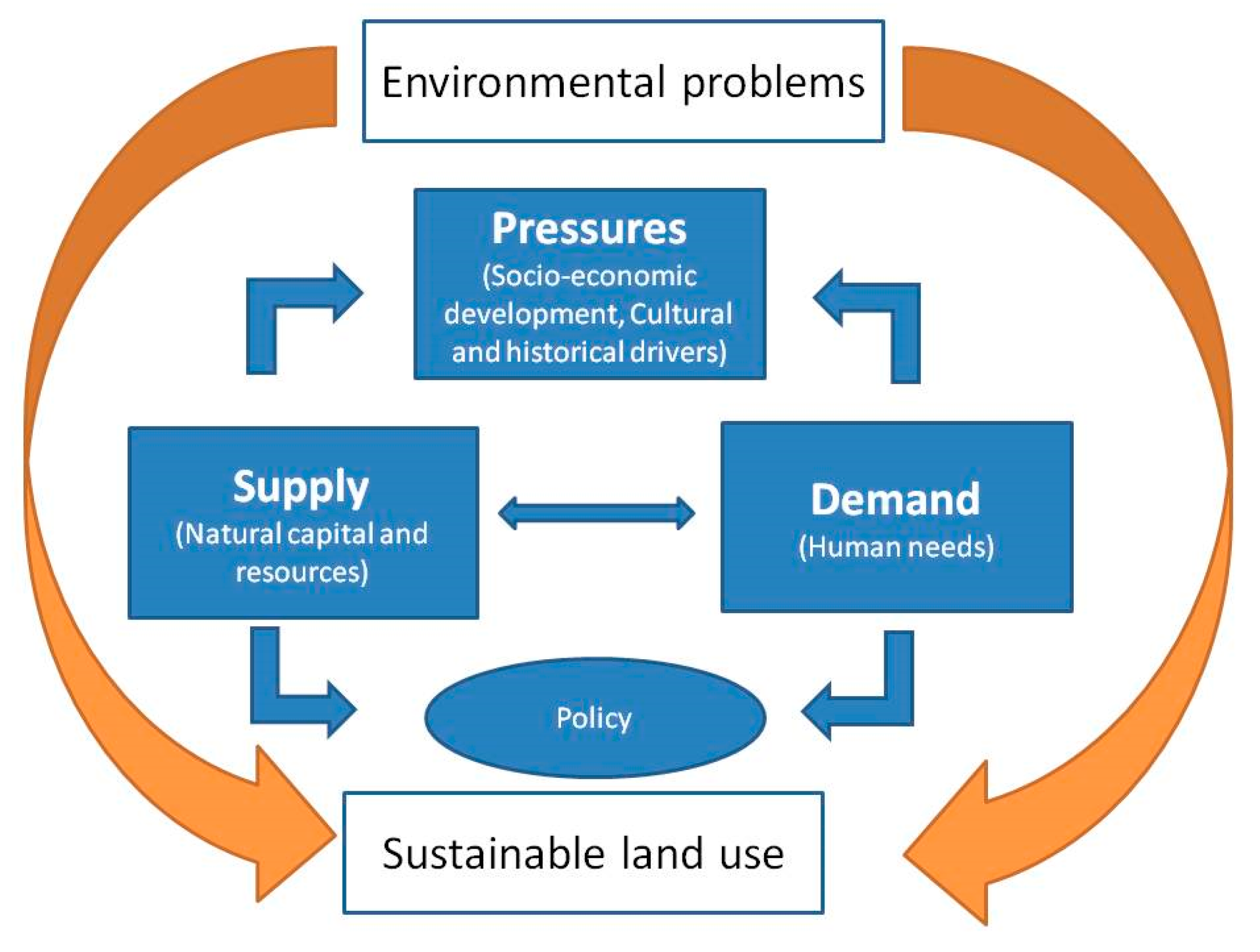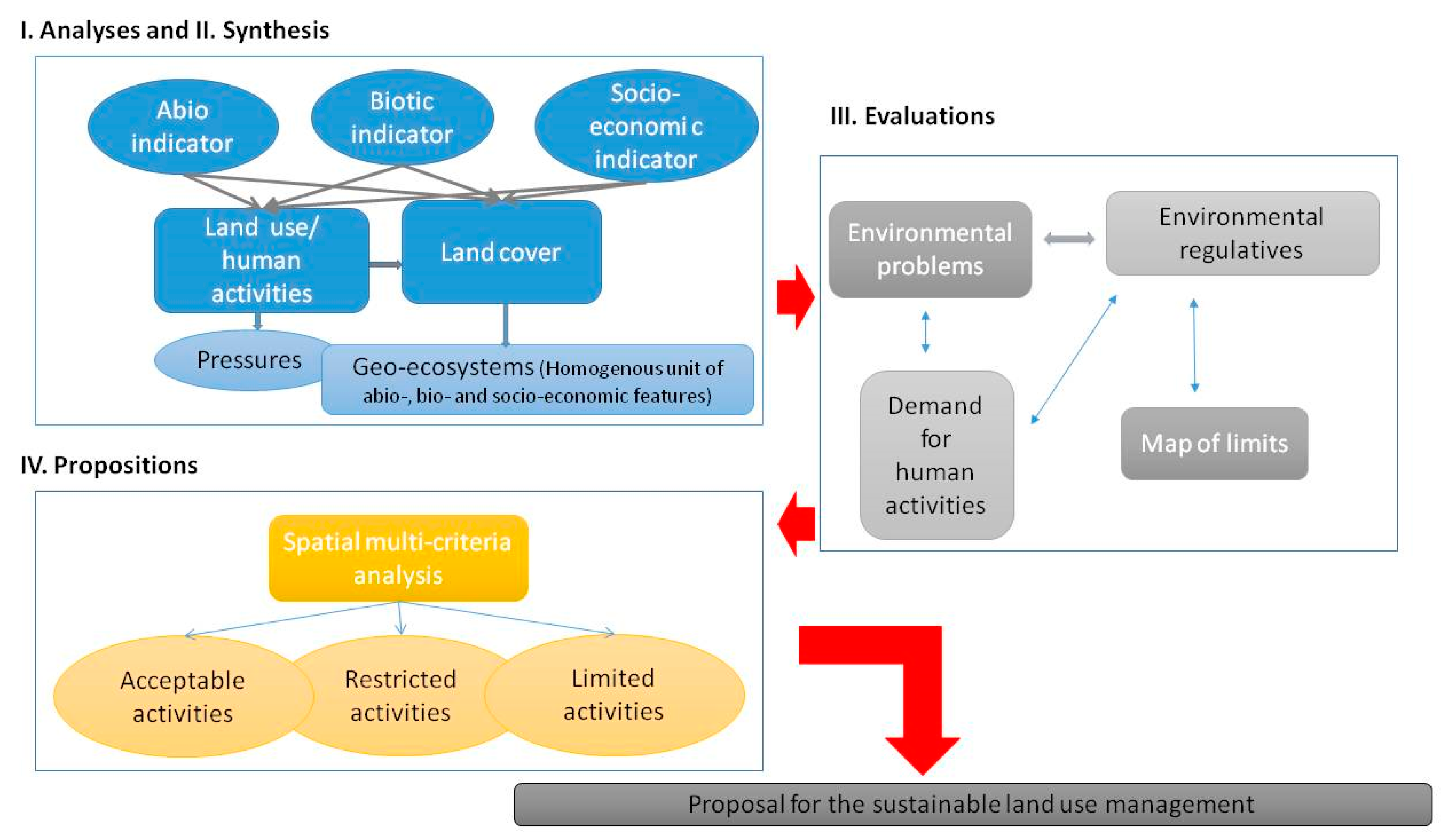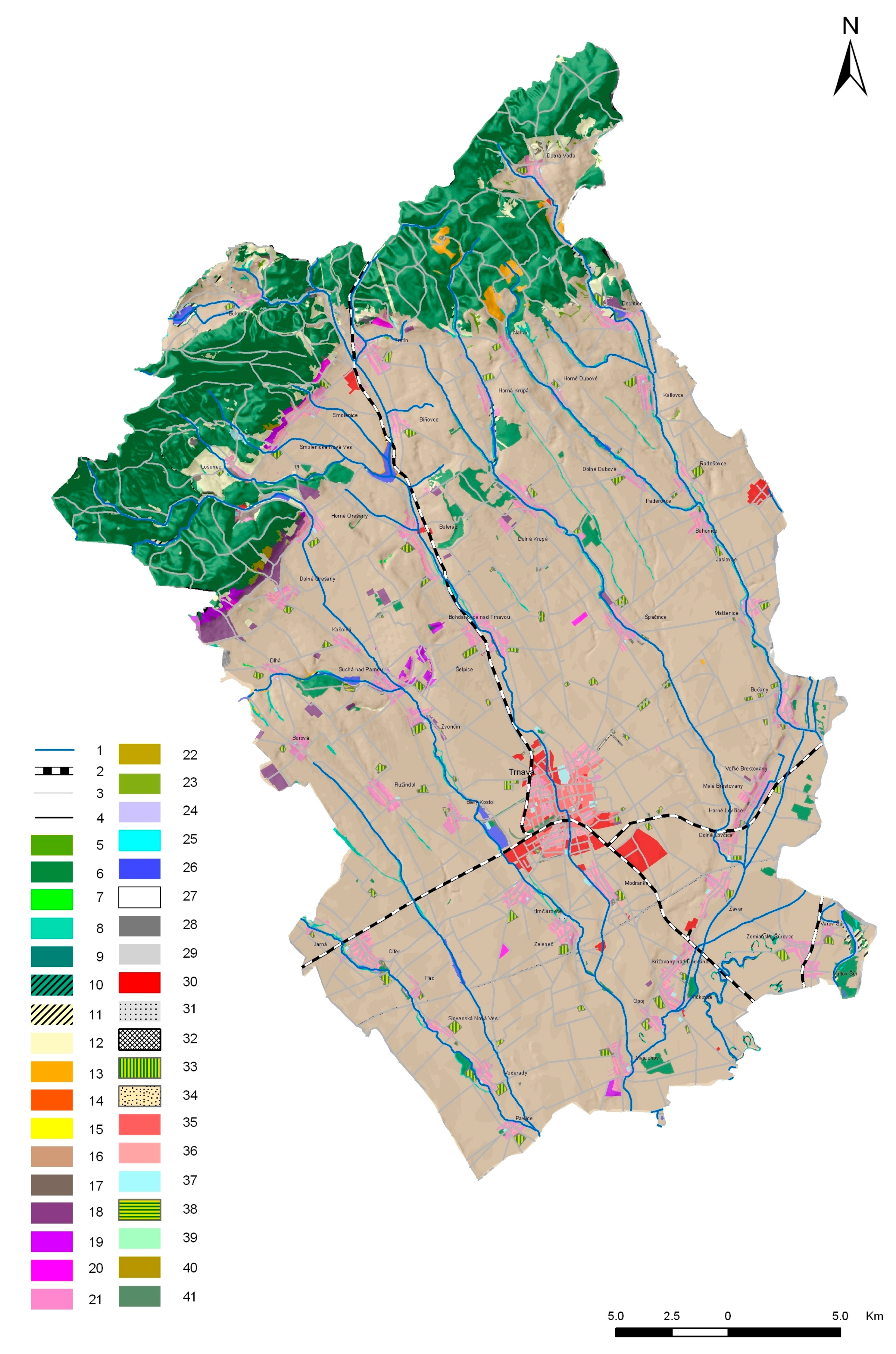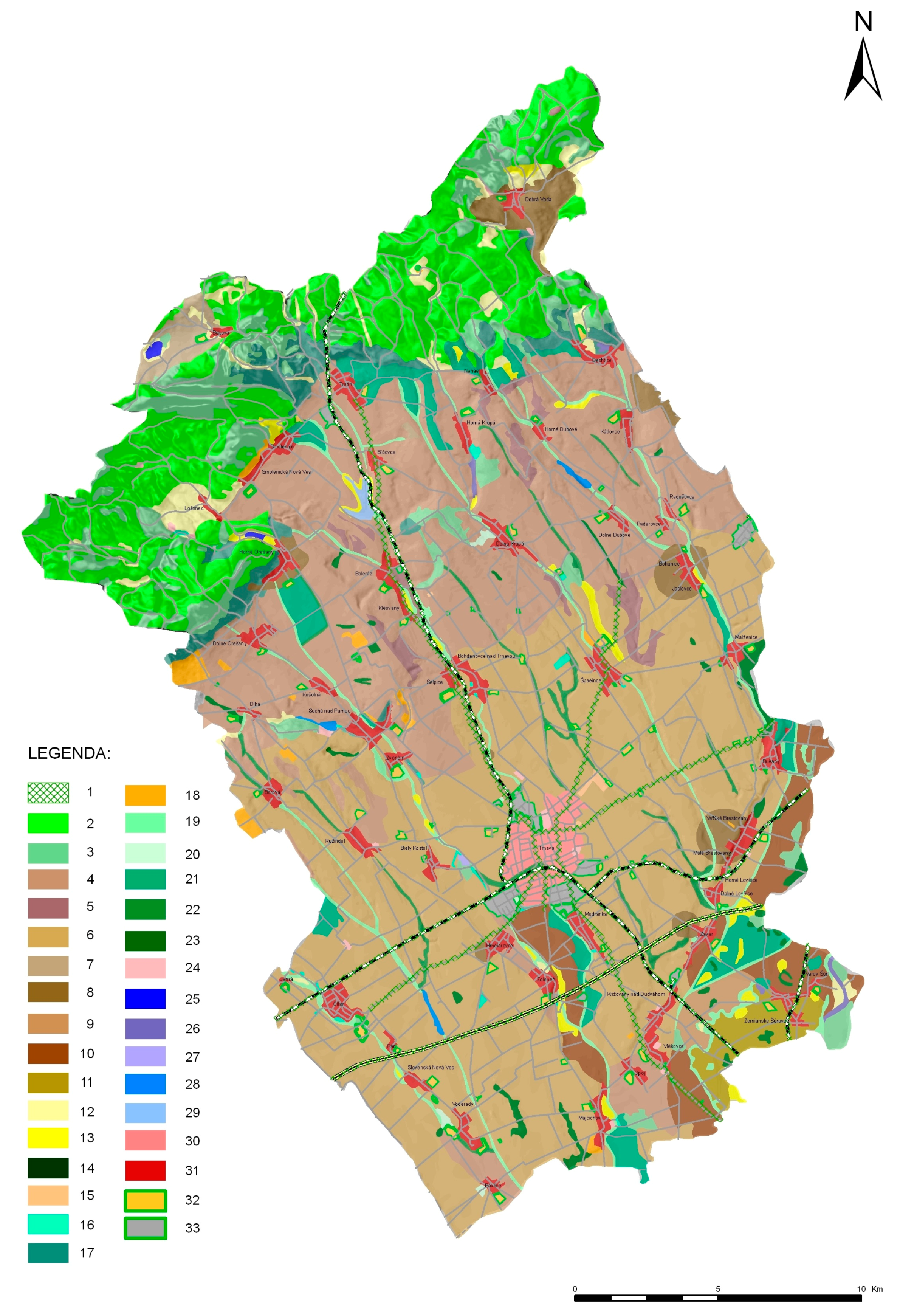Integrated Approach to Sustainable Land Use Management
Abstract
:1. Introduction
- the need to ensure and improve spatial stabilization of the territory. The stated criterion here is the demand to achieve biological balance in the country;
- needs for nature protection and rational utilization of natural resources; in particular, the protection of the land, water, forests, and gene pool;
- needs for the protection of cultural and historical resources;
- needs for the regeneration of human resources and the protection of human health;
- demands on the humanization and aesthetic appeal of the landscape.
2. Methods
2.1. Methodological Approach
- analysis of geomorphological features, geological, hydrological, soil, and climatic conditions. This establishes the properties of abiotic complexes in the territory.
- analysis of fauna and flora and their conditions determines the properties of the biotic complexes.
- analysis of the socioeconomic activities and their negative influences supplies the properties of the socioeconomic complexes.
- areas used for building construction and complexes, industrial and agricultural complexes, and communication lines and facilities.
- extensive use of the landscape for agriculture and forestry.
- definition of functional zones and protected areas. These include recreational zones and areas protected for soil and water resources and nature.
- The pressures connected with the performance of these activities can also initiate atmospheric pollution and soil and water contamination.
- activities possible in the given area. This includes multiple ranking of suitability from different perspectives.
- activities not possible in the given area.
- limits and restrictions, including a combination of limits and restrictions, required to exclude particular activities from target localities.
2.2. Study Area
3. Results
3.1. Landscape Features and Proposed Limits
- Abiotic regulations are based on abiotic complexes including geo-mechanical, hydrological, aerodynamic, and soil limitations. The limits have a permanent character including the relative stability of the geological substratum and local climate, and these cannot be easily changed by technology.
- Biotic regulations are based on the biotic complexes required by living organisms. The gene pool, biodiversity, and landscape ecological stability are threatened by pressures from human activity and land use changes.
- Anthropogenic regulations result from the competitive requirements and demands of human activities which limit the development of other activities through negative effects or by simply occupying an area. These include technical, hygienic, protective, and other limits, and these indicators are relatively easier to change than in the preceding categories. Although anthropogenic regulations are applied to very serious hygienic and environmental security demands, the limits imposed can be temporary and depend on altered circumstances.
- Complex landscape regulations are based on the principles of landscape functioning as a complex. They include eco-stabilization, localization, carrying-capacity, behavioral, aesthetic, and cultural-historical limits. These limits are very dynamic as they result from principles of the operation of landscape as an entity and the set limits must strictly respect its historical development.
3.2. The Impact of Land Use Changes
- Conflicts between the socioeconomic development of nature protection; (1) building stones are extracted in the Small Carpathian Mts. Protected Landscape Area. Extraction is profitable only for entrepreneurs and the employment rate is insignificant. It is therefore deemed necessary to eliminate these mining activities in the protected areas; (2) recreational areas have been developed in the Small Carpathian Mts. and in the Trnavske rybníky fishponds Protected Area. Planned tourist attraction there can negatively affect the natural landscape and especially the avian population. This presents conflict between economical development and nature protection.
- Conflicts in socioeconomical development and natural resource protection; (1) there is competing interest in industrial development and the protection of the most fertile Trnava soils. The recent building boom has appropriated ‘green fields’, with the best quality soils to be used for industry, industrial parks, and housing, while many existing industrial sites lay abandoned with decreased economic value. It would be advantageous for sustainable development and regional economics if these abandoned sites were refurbished and re-used instead of expanding the industrial occupation of ecologically-valuable green fields; (2) intensive agricultural practices have led to both surface and underground water endangerment; and (3) inappropriate soil management promotes soil degradation, including compaction and erosion.
- Conflicts in nature protection and society; for example, protected areas for hygienic water resource protection and other protective zones limit the land use of some areas. These zones require essential limits in socioeconomic and urban development, including inappropriate property acquisition and utilization rights. However, unsatisfactory compensation and loss of profit create competing interests between nature protection and social justice, and this conflict requires urgent solutions.
- Conflicts in socioeconomic development and environmental quality; while industrial operators are significant employers, fundamental regional economics compete with extreme environmental load. It is currently impossible to close industries because of significant unemployment and regional economical efficiency. It is therefore essential to promote effective technology which limits contaminant production and ensures sustainable development.
3.3. Proposal for Sustainable Land Use Management
- Abiotic conditions are the determining factors in a given area’s diversity. They establish appropriate area utilization. The abiotic elements’ permanent and unique attributes become determining factors in human development.
- Land use management must reduce the risk factors in sensitive localities which are otherwise predisposed to anthropogenic degradation processes including erosion, subsidence, landslides, and earthquakes.
- It is essential to support development in NATURA 2000 protected territories and ecologically valuable areas of stability. This enables scientific and medical research centers, which encourage appropriate recreational areas and reduce threats to natural landscape units.
- Similarly, the development of human activities with negative impacts must be excluded in areas where natural resources are legally protected, and explicit priority must be given to developing activities which protect individual natural resources.
- All detrimental activities must be excluded from sensitive areas with strong pressure burden. These include areas with air-pollution, soil or water contamination, and noise pollution.
- Areas without pressure loads should be maintained free from activities which can harm current living quality. These areas are suitable for high-quality living development with adequate agricultural, ecological, and recreation services.
- Selection and exclusion of activities which cannot be located on a given area because of possible landscape-ecological harm.
- Selection and restriction of activities which can be conducted on an area, but which can cause landscape-ecological damage if unrestricted.
- Selection of a hierarchy of activities which maintain the area’s optimal landscape-ecological function.
- Selection of complex measurements required to protect the area’s nature, natural resources, and environment.
4. Discussion
5. Conclusions
- The regulations for optimal land use must be applied to sector plans—it is unavoidable that the regulated use of particular resources by production and non-production entities favors the development of one area over another and/or fails to avoid conflicts of interest.
- The principles of sustainable development should be implemented with as much population awareness as possible, especially for stakeholders and policymakers—this requirement is based on creating an effective system of education in sustainable development and land use management, because adequate education enhances public acceptance of the principles and criteria for practical sustainable development.
- To ensure the promotion of effective tools for legislative protection and economic outcomes, it is essential that legislative rules and regulations support the rational use of natural resources and protect both the environment and human health. Economic tools such as taxes, duties, and fees support both decision-making and sustainable landscape-ecological policy. Fines imposed for inappropriate land use, environmental pollution, human health endangerment or injury, and breach of regulations help eliminate environmental problems. Finally, subsidies from rural development programs and other sources help reduce marginality and social disparity in rural communities.
Acknowledgments
Author Contributions
Conflicts of Interest
References
- Axelsson, R.; Angelstam, P.; Elbakidze, M.; Stryamets, N.; Johansson, K.-E. Sustainable Development and Sustainability: Landscape Approach as a Practical Interpretation of Principles and Implementation Concepts. J. Landsc. Ecol. 2012, 4, 5–30. [Google Scholar] [CrossRef]
- Findell, K.L.; Berg, A.; Gentine, P.; Krasting, J.P.; Lintner, B.R.; Malyshev, S.; Santanello, J.A., Jr.; Shevliakova, E. The impact of anthropogenic land use and land cover change on regional climate extremes. Nat. Commun. 2017, 8. [Google Scholar] [CrossRef] [PubMed]
- Brundtland, G.; Khalid, M.; Agnelli, S.; Al-Athel, S.; Casanova, P.G.; Chidzero, B.; Padika, L.; Hauff, V.; Lang, I.; Shijun, M.; et al. Our Common Future; Brundtland Report; Oxford University Press: Oslo, Norway, 1987; Available online: www.un-documents.net/our-common-future.pdf (accessed on 2 February 2018).
- IISD. Sustainable Development. 2016. Available online: http://www.iisd.org/topic/sustainable-development (accessed on 4 December 2017).
- IUCN. Caring for the Earth. In A Strategy for Sustainable Living; IUCN, UNEP, WWF: Glad, Switzerland, 1991. [Google Scholar]
- Potschin, M.; Haines-Young, R. Landscapes, sustainability and the place-based analysis of ecosystem services. Landsc. Ecol. 2013, 28, 1053–1065. [Google Scholar] [CrossRef]
- Ružička, M.; Miklós, L. Basic Premises and Methods in Landscape Ecological Planning and Optimization. In Changing Landscapes: An Ecological Perspective; Zonneveld, I.S., Forman, R.T.T., Eds.; Springer: New York, NY, USA, 1990; pp. 233–260. Available online: http://link.springer.com/chapter/10.1007/978-1-4612-3304-6_13 (accessed on 8 December 2014).
- De Sherbinin, A. A CIESIN Thematic Guide to Land-Use and Land-Cover Change (LUCC); Center for International Earth Science Information Network (CIESIN) Columbia University Palisades: Palisades, NY, USA, 2002; Available online: http://sedac.ciesin.columbia.edu/guides (accessed on 28 November 2017).
- De Groot, R.S.; Alkemade, R.; Braat, L.; Hein, L.; Willemen, L. Challenges in integrating the concept of ecosystem services and values in landscape planning, management and decision making. Ecol. Complex. 2010, 7, 260–272. [Google Scholar] [CrossRef]
- Bürgi, M.; Hersperger, A.M.; Schneeberger, N. Driving forces of landscape change—Current and new directions. Landsc. Ecol. 2004, 19, 857–868. [Google Scholar] [CrossRef]
- Hersperger, A.M.; Buergi, M. Driving Forces of Landscape Change in the Urbanizing Limmat Valley, Switzerland. In Modelling Land-Use Change: Progress and Applications; Koomen, E., Stillwell, J., Bakema, A., Scholten, H.J., Eds.; Springer: Dordrecht, The Netherlands, 2007; pp. 45–60. [Google Scholar]
- Wohlmeyer, H.F.J. The unconscious driving forces of landscape perception and formation. In Sustainable Development of Multifunctional Landscapes; Helming, K., Wiggering, H., Eds.; Springer: New York, NY, USA, 2003; pp. 79–93. [Google Scholar]
- Miklós, L.; Izakovičová, Z. Krajina Ako Geosystém (Landscape as Geo-Ecosystem); VEDA Publishing of the Slovak Academy of Sciences: Bratislava, Slovakia, 1997. [Google Scholar]
- Braunisch, V.; Patthey, P.; Arlettaz, R.L. Spatially explicit modeling of conflict zones between wildlife and snow sports: Prioritizing areas for winter refuges. Ecol. Appl. 2011, 21, 955–967. [Google Scholar] [CrossRef] [PubMed]
- Frost, P.; Campbell, B.; Medina, G.; Usongo, L. Landscape-Scale Approaches for Integrated Natural Resource Management in Tropical Forest Landscapes. Ecol. Soc. 2006, 11. Available online: https://www.ecologyandsociety.org/vol11/iss2/art30/ (accessed on 30 November 2017). [CrossRef]
- Falťan, V.; Krajcirovičová, L.; Petrovič, F.; Khun, M. Detailed Geoecological Research of Terroir with the Focus on Georelief and Soil—A Case Study of Kratke Kesy Vineyards. Ekologia (Bratislava) 2017, 36, 214–225. [Google Scholar] [CrossRef]
- Miklos, L. Landscape-ecological theory and methodology: A goal oriented application of the traditional scientific theory and methodology to a branch of a new quality. Ekologia (Bratislava) 1996, 15, 377–385. [Google Scholar]
- Antrop, M. Why landscapes of the past are important for the future. Landsc. Urban Plan. 2005, 70, 21–34. [Google Scholar] [CrossRef]
- Barančoková, M.; Kenderessy, P. Assessment of Landslide Risk Using Gis and Statistical Methods in Kysuce Region. Ekologia (Bratislava) 2014, 33, 26–35. [Google Scholar] [CrossRef]
- Jakab, I.; Petluš, P. The Use of Viewshed Analysis in Creation of Maps of Potential Visual Exposure. In GIS OSTRAVA 2013—Geoinformatics for City Transformation; Ivan, I., Longley, P., Fritsch, D., Horak, J., Cheshire, J., Inspektor, T., Eds.; Publisher VSB-TECH UNIV Ostrava: Ostrava, Czech Republic, 2012; pp. 375–390. [Google Scholar]
- Vyskupova, M.; Pavlickova, K.; Baus, P. A landscape vulnerability analysis method proposal and its integration in the EIA. J. Environ. Plan. Manag. 2017, 60, 1193–1213. [Google Scholar] [CrossRef]
- Reimer, M.; Getimis, P.; Blotevogel, H.H. Spatial Planning Systems and Practices in Europe. A comparative perspective. In Spatial Planning Systems and Practices in Europe: A Comparative Perspetive on Continuity and Changes; Reimer, M., Getimis, P., Blotevogel, H.H., Eds.; Routledge: Abingdon, UK, 2014; pp. 1–20. [Google Scholar]
- Orsi, F.; Geneletti, D.; Borsdorf, A. Mapping wildness for protected area management: A methodological approach and application to the Dolomites UNESCO World Heritage Site (Italy). Landsc. Urban Plan. 2013, 120, 1–15. [Google Scholar] [CrossRef]
- Izakovičová, Z.; Mederly, P.; Petrovič, F. Long-Term Land Use Changes Driven by Urbanisation and Their Environmental Effects (Example of Trnava City, Slovakia). Sustainability 2017, 9, 1553. [Google Scholar] [CrossRef]
- Bastian, O. Ecosystem and Landscape Services: Development and Challenges of Disputed Concepts. In Landscape and Landscape Ecology; Halada, L., Baca, A., Boltiziar, M., Eds.; ILE SAS: Bratislava, Slovakia, 2016; pp. 215–226. [Google Scholar]
- Izakovičová, Z.; Moyzeová, M.; Oszlányi, J. Problems in Agricultural Landscape Management Arising from Conflicts of Interest—A Study in the Trnava Region, Slovak Republic. In Innovations in European Rural Landscapes; Wiggering, H., Ende, H.-P., Knierim, A., Pintar, M., Eds.; Springer: Berlin/Heidelberg, Germany, 2010; pp. 77–95. Available online: http://link.springer.com/chapter/10.1007/978-3-642-04172-3_6 (accessed on 8 December 2014).
- Schulte, R.P.O.; Creamer, R.E.; Donnellan, T.; Farrelly, N.; Fealy, R.; O’Donoghue, C.; O’hUallachain, D. Functional land management: A framework for managing soil-based ecosystem services for the sustainable intensification of agriculture. Environ. Sci. Policy 2014, 38 (Suppl. C), 45–58. [Google Scholar] [CrossRef]
- Labuda, M. Multifunkčné pol’nohospodárstvo ako nástroj ekologickej ochrany kultúrnej krajiny (Multifunction Agriculture as the Instrument of Ecological Cultural Landscape Protection). Životné Prostr. 2011, 45, 38–42. [Google Scholar]
- Surova, D.; Surovy, P.; de Ribeiro, N.A.; Pinto-Correia, T. Integrating differentiated landscape preferences in a decision support model for the multifunctional management of the Montado. Agrofor. Syst. 2011, 82, 225–237. [Google Scholar] [CrossRef]
- Sturck, J.; Verburg, P.H. Multifunctionality at what scale? A landscape multifunctionality assessment for the European Union under conditions of land use change. Landsc. Ecol. 2017, 32, 481–500. [Google Scholar] [CrossRef]
- Böhmelt, T.; Bernauer, T.; Buhaug, H.; Gleditsch, N.P.; Tribaldos, T.; Wischnath, G. Demand, supply, and restraint: Determinants of domestic water conflict and cooperation. Glob. Environ. Chang. 2014, 29 (Suppl. C), 337–348. [Google Scholar] [CrossRef]
- Reháčková, T.; Pauditšová, E. Evaluation of urban green spaces in Bratislava. Boreal Environ. Res. 2004, 9, 469–477. [Google Scholar]
- Miklós, L.; Miklisova, D.; Reháková, Z. Systematization and Automatization of Decision-Making Process in Landep Method. Ekologia ČSFR 1986, 5, 203–231. [Google Scholar]
- Hrnčiarová, T. Abiotic complexes—An important part of ecological decision making in agricultural landscape. Ekologia (Bratislava) 2005, 24, 397–410. [Google Scholar]
- Drábová-Degro, M.; Krnáčová, Z. Assessment of Natural and Cultural Landscape Capacity to Proposals the Ecological Model of Tourism Development (case Study for the Area of the Zamagurie Region). Ekologia (Bratislava) 2017, 36, 69–87. [Google Scholar] [CrossRef]
- Wade, A.A.; Theobald, D.M.; Laituri, M.J. A multi-scale assessment of local and contextual threats to existing and potential US protected areas. Landsc. Urban Plan. 2011, 101, 215–227. [Google Scholar] [CrossRef]
- Krnáčová, Z.; Hrnčiarova, T. Landscape-ecological planning—A tool of functional optimization of the territory (case study of town Bratislava). Ekologia (Bratislava) 2006, 25, 53–67. [Google Scholar]
- Antrop, M. From holistic landscape synthesis to transdisciplinary landscape management. In From Landscape Research to Landscape Planning: Aspects of Integration, Education and Application; Tress, B., Tres, G., Fry, G., Opdam, P., Eds.; Springer: Dordrecht, The Netherlands, 2006; Volume 12, pp. 27–50. [Google Scholar]
- Gratton, M.; Morin, S.; Germain, D.; Voiculescu, M.; Ianas, A. Tourism and natural hazards in Balea Glacial area valley, Faragas massif, Romanian Carpathians. Carpathian J. Earth Environ. Sci. 2015, 10, 19–32. [Google Scholar]
- Hrnčiarová, T.; Izakovičová, Z.; Miklós, L.; Lehotský, M.; Tremboš, P.; Durajková, N.; Ot’ahel’, J. Environmental-Conditions of Formation and Development of Regions in Slovakia. Ekologia (Bratislava) 1994, 13, 87–94. [Google Scholar]
- Belčáková, I.; Pšenáková, Z. Specifics and Landscape Conditions of Dispersed Settlements in Slovakia—A Case of Natural, Historical and Cultural Heritage. In Best Practices in Heritage Conservation and Management: From the World; Piscitelli, M., Ed.; Scuola Pitagora Editrice: Napoli, Italy, 2014; Volume 46, pp. 261–268. [Google Scholar]
- Lambin, E.F.; Turner, B.L.; Geist, H.J.; Agbola, S.B.; Angelsen, A.; Bruce, J.W.; Coomes, O.T.; Dirzo, R.; Fischer, G.; Folke, C.; et al. The causes of land-use and land-cover change: Moving beyond the myths. Glob. Environ. Chang. 2001, 11, 261–269. [Google Scholar] [CrossRef]
- Muchova, S.; Svecova, A.; Pavlickova, K.; Zelenakova, M. Evaluation of the development potential in optimisation of the area using. Ekologia (Bratislava) 2006, 25 (Suppl. 1), 179–189. [Google Scholar]
- Saarikoski, H.; Mustajoki, J.; Barton, D.N.; Geneletti, D.; Langemeyer, J.; Gomez-Baggethun, E.; Marttunen, M.; Antunes, P.; Keune, H.; Santos, R. Multi-Criteria Decision Analysis and Cost-Benefit Analysis: Comparing alternative frameworks for integrated valuation of ecosystem services. Ecosyst. Serv. 2016, 22, 238–249. [Google Scholar] [CrossRef]
- Pauditšová, E.; Slabeciusova, B. Modelling as a Platform for Landscape Planning. In Geoconference on Informatics, Geoinformatics and Remote Sensing; Stef92 Technology Ltd.: Sofia, Bulgaria, 2014; Volume III, pp. 753–760. [Google Scholar]
- Sklenicka, P. Applying evaluation criteria for the land consolidation effect to three contrasting study areas in the Czech Republic. Land Use Policy 2006, 23, 502–510. [Google Scholar] [CrossRef]
- Juskova, K.; Muchova, Z. Land Consolidation as an Instrument for Land Ownership Defragmentation. In MENDELNET 2013; Skarpa, P., Ryant, P., Cerkal, R., Polak, O., Kovarnik, J., Eds.; Mendel Univ Brno: Brno, Czech Republic, 2013; pp. 444–448. [Google Scholar]
- Muchova, Z.; Leitmanova, M.; Petrovic, F. Possibilities of optimal land use as a consequence of lessons learned from land consolidation projects (Slovakia). Ecol. Eng. 2016, 90, 294–306. [Google Scholar] [CrossRef]





| Stress Factors | Air Pollution | Noise Load Area | Soil Contamination | Polluted Water Flows | Damage of Vegetation | Radio Activity | Nature Reserve | Protected Zone of Water Resources |
|---|---|---|---|---|---|---|---|---|
| Land Use Activities | ||||||||
| forests (F) | 1 | 1 | 1 | 1 | 1 | 1 | 1 | 1 |
| grassland (G) | 1 | 1 | 1 | 1 | 1 | 1 | 1 | 1 |
| pastures (P) | L | 1 | L | - | L | L | L | L |
| vineyards (V) | L | 1 | L | - | L | L | L | 0 |
| forage-crops (C) | L | 1 | L | - | L | L | L | 0 |
| arable land (A) | 0 | 1 | 0 | - | 0 | 0 | L | 0 |
| orchards (O) | 0 | 1 | L | - | L | 0 | L | 0 |
| gardens (GS) | L | 1 | L | - | L | L | L | 0 |
| recreation (R) | L | L | L | L | L | L | L | 0 |
| sport areas (S) | L | L | L | L | L | L | L | 0 |
| medical areas (M) | L | L | L | - | L | L | L | 1 |
| housing areas (H) | L | L | L | - | L | L | L | L |
| farm animals (FA) | L | L | L | - | 0 | L | L | L |
| industrial areas (I) | 1 | 1 | 1 | - | 1 | 1 | L | L |
| transport areas (T) | 1 | 1 | 1 | - | 1 | 1 | L | L |
| Unlimited activities/acceptable activities | I, T, F, G/A, O | F, G, P, V, C, A, O, GS, I, T | I, T, F, G/A | F, G | I, T, F, G/A, FA | F, G, I, T/O, A | F, G/- | F, G, M/V, C, A, O, GS, R, S |
© 2018 by the authors. Licensee MDPI, Basel, Switzerland. This article is an open access article distributed under the terms and conditions of the Creative Commons Attribution (CC BY) license (http://creativecommons.org/licenses/by/4.0/).
Share and Cite
Izakovičová, Z.; Špulerová, J.; Petrovič, F. Integrated Approach to Sustainable Land Use Management. Environments 2018, 5, 37. https://doi.org/10.3390/environments5030037
Izakovičová Z, Špulerová J, Petrovič F. Integrated Approach to Sustainable Land Use Management. Environments. 2018; 5(3):37. https://doi.org/10.3390/environments5030037
Chicago/Turabian StyleIzakovičová, Zita, Jana Špulerová, and František Petrovič. 2018. "Integrated Approach to Sustainable Land Use Management" Environments 5, no. 3: 37. https://doi.org/10.3390/environments5030037





